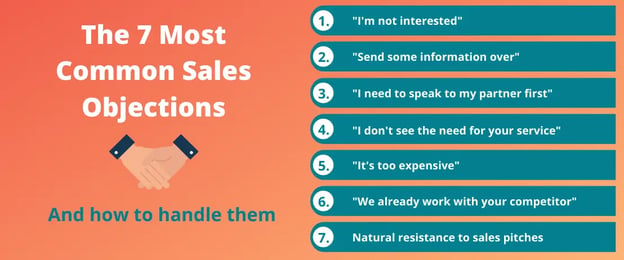“Thanks, but no thanks”
Sound familiar?
When a prospect seems to have an issue buying your product, you might get hit by something called the sales objection. This is when the customer communicates to the sales representative their qualms with the product.
This rejection might be a firm no, or there might be a chance you can turn it around.
Let’s take a look at objection handling and some examples that keep the conversation going with your customer.
Objection Handling 101
Sales objections are a necessary and regular part of your daily business operations.
It is necessary because it helps you understand the pain points in your product or services and gives you the chance to work on them to improve your reach.
It’ll be something you encounter from time to time, because let’s face it, not every customer that comes across your product or service will end up investing in it.
However, as we said, not every rejection equals a big fat NO, and a good sales representative knows that.
Customers will always have reservations when they are spending their money. It’s on the salesperson to encourage trust and confidence. This is where fine-tuned objection handling comes in.
What is Objection Handling?
Objection handling means responding to the customers by understanding the issues they face and giving them possible solutions to mitigate them.
In simpler words, you give them a chance to rethink their decision by reiterating the good things about your product, and reframe any negative attributes.
Here’s a scenario where objection handling is needed:
Say you have a company that sells vacuum cleaners.
Your prospect already owns a vacuum cleaner and while they do seem interested, they aren’t really sure if they should shell out for a more expensive one.
As much as they want to buy your product, the price is a little too steep for them.
“Sorry it’s just a little out of my budget” they say.
So what do you do?
As a sales representative, your job is to understand this gap and act as a bridge. If price is an issue, tell them how the product packs a punch for the budget.
Highlight the great aspects of the vacuum cleaner that makes it the best in the market. For instance, talk about the extended warranty, the powerful cleaning motors, and the unlimited attachments that offer them a 360˚ clean.
Give them not one, but multiple reasons to invest in your product. If they are able to see the value, those negative opinions will start to fade away.
Why is Objection Handling Important?
Opinion handling helps you to establish a new relationship with a potential buyer who has doubts. It is pivotal in making that customer feel heard. It also helps people see your brand as dedicated and sympathetic to their pain points.
But that’s not all. Objection handling also:
- Helps you understand if your sales team is efficient enough to convert leads.
- Tells you if the leads you are chasing are a real opportunity.
- Indicates whether you are promoting your value proposition effectively.
- Gives you an insight into your brand’s sales strategy and your skills as a sales rep.
How To Overcome a Sales Objection?
There is so much information and learning material available on overcoming sales objections.
Practical knowledge about your product and being prepared for any scenario is what will help the most.
In order to be fully prepared, your training should involve sales roleplay, so that you can test whether or not you are ready to handle delicate customer queries.
These are some tips you can incorporate not only when you email your customers, but as you’re face-to-face with them. We recommend you try them out internally with your team first.
- Become an active listener
The golden rule of being an excellent sales representative is to have impeccable listening skills. Your prospect is sharing some concerns regarding your product and disclosing their likes and dislikes.
Let them finish before voicing your opinion on the matter and listen to them patiently. Let them know that you’re listening to whatever they have to say, with a small ‘yes’, or an ‘I understand”, but don’t interrupt unless absolutely necessary.
Sometimes, customers tend to go overboard with their criticism, so you be the smarter one and try to be as subtle and calm as you can be.
- Get a better understanding of the issue
Repeat to them what you’ve just heard. Ask them if what you’ve understood from your conversation so far is in line with their concerns.
It helps to frame it “SWOT style” and discuss the weaknesses and threats while countering with some strengths and opportunities.
Additionally, the client will feel that their issues are being heard and they are getting the necessary attention, which helps you gain their trust.
- Agree with the prospect, to whatever extent you can
We are not asking you to go out on a limb and agree to everything they have to say, but agree to most of their concerns.
Let’s go back to the vacuum cleaner.
If the client says that the model is exceptionally high on price, respond with,
‘I completely agree with what you’re saying. We are a highly-priced model, but we also offer great value for money. You’d be surprised how useful the 10 extra attachments are to help you clean every nook and corner of your house…’ and so on.
- Ask the right questions
Always ask relevant follow-up questions. Relevant being the operative word here.
You can’t sell a non-stick induction frying pan to someone who doesn’t own an induction cooktop.
You don’t want them to waste time over useless banter. Instead, you want them to give you clear answers that will help you draft your points better.
Also, let’s just refrain from asking questions in a simple ‘yes’ or ‘no’. No problem is as simple as that. You want them to answer your questions in depth and you won’t get that unless your questions demand a better explanation.
- Real-life anecdotes work
Tell them about another couple, who replaced their vacuum cleaner with yours, and the positive feedback you received. Sharing the success story of another customer with a prospect really helps establish credibility for your brand. It also encourages the prospect to rethink their decision of not investing in your product.
What could really help is a good social media page for your product/service. When they see that there are people who have used your product and have been happy with their purchase, they automatically become more inclined towards saying a yes.
- Ask them a suitable time for a follow-up
It is natural for your prospects to ponder over their decision. If they ask you for more time to think over it, give it to them. In fact, consider it a great sign because you just managed to pull the wall down on a straight no.
However, you don’t want them to take too long so ask them for an appropriate time to follow up and stick to that time. If they ask you for a day or two, be polite and say, ‘Please take all the time you need. We look forward to having you as a valuable customer’. You need them as much as they need you, so ensure that the communication stays smooth and positive.
- Keep a track of the complaints
They say prevention is better than cure and rightly so.
As a business owner or a sales representative, you should have a knack for understanding if the prospect is going to materialise or not. When you are already aware of the outcome or are able to anticipate them, you are better prepared to face them.
So how do you do that? It’s simple. By listening.
Like we mentioned above, your first skill is to be a patient and active listener. Interrupting clients with a knockout reply does not build a business, addressing issues does.
Also, you get an idea if the concerns raised hold ground or are simply arrows in the air. This further helps in putting your resources to good use and wasting less time on open-ended prospects.
Simple Email Tips for Salespeople
We’ve given you some tips that fit in person, over the phone or basically any channel. Now let’s focus just on emails. As you get into the habit of sending out a lot of emails for sales, there are a few tips that will make a big impact on your workflow.
- Email Templates: You’re likely addressing the same concerns over and over again, so save your best replies as templates. You can set them up to automatically personalize.
- Email Recall: What if you hit send too soon? This could end up being a pretty hairy situation if you’ve said the wrong thing. Make sure you have an email app that enables undo send.
- Email Tracking: You can gain a lot of information if you track your emails. Know whether or not your email has landed but is just sitting there waiting to be read. Figure out what time is the best time to reach out to your audience.
Common Objection Handling Emails

We have taken the liberty of getting you started with some prompts for commonly heard sales objections and their responses.
So, let’s get started:
- "That's too expensive."
Price is the biggest pain point and the most common reason for a client rejecting a product or a service.
They tend to overlook the features and concentrate on the hole burning in their pocket. There are times when you’re unaware of the client budget, so make sure that you sound comforting and understanding before proceeding further with the conversation. Let’s see how you can turn this situation around in your favour:
Client: “Hm, that’s a little expensive for me”
Response:
“We completely understand, there is always going to be hesitancy when it comes to price, but most of the time what people find is that the other benefits outshine that aspect.
How about we take you through all the amazing features we have to offer. We can always come back to pricing later, once you get an idea of the value our product brings. What do you think?”
- "I am not interested."
As rude as that might sound, it is one of the most common responses from a prospect. However, this response follows a lot of reasons, like they might have been using a separate alternative, or they don’t have the time to listen to a new product, or they are not interested in having a long conversation. There are different responses for each of these points so pay close attention:
Response 1:
Client: “I am not interested because I don’t have the budget”
Response: “Not a problem. Perhaps we can explore more options that are better and more economical? What do you think? Something you’d be interested in?”
Response 2:
Client: “I am not interested because I use another product which is much cheaper.”
Response: “Oh yes, XYZ is a decent product. However, our products offer you ABC benefits which your current product doesn’t offer. Additionally, in terms of longevity, let’s compare the two. How often do you replace XYX?”
Response 3:
Client: “I am not interested because I don’t have the time right now.”
Response: “That’s not a problem at all. I can totally call you at a time more suitable for you. I think you’ll find the presentation really informative and hassle-free, just let me know when is a good time to follow up with you.”
All three responses are polite, to the point and ensure that the conversation is up and running. A dead-end response will take you nowhere, so keep it going with a question or a statement that makes them come to you.
- "Your product doesn't seem like a good fit."
The objection is directed towards the value that your product/ service will eventually add to the client’s life. The answer to this needs to highlight the great aspects of your product that will act as a painkiller for the client. For instance:
Client: “I don’t think that I really need your product. It doesn’t seem like a good fit.”
Response: “I completely understand where you’re coming from. Perhaps you feel like that because you are not fully aware of the product features. Why don’t I share a small story with you? It is from one of our clients who recently started using our product. How does that sound?”
Now, the client is interested because no one wants to miss out on a great story. Secondly, it paints a steady and reliable picture of your brand because you have a lot of people who trust your product.
- "I don't have the authority."
Probably the easiest objection in the book is this statement right here. People take this route when they have no other answer, or they genuinely do not have the authority. In most cases, prospects do come forward and tell you exactly why they say they are not authorised, but there are times when they are not as forthcoming with the information. Either way, your response should be very professional. Crisp and to the point.
Client: “I don’t have the authority.”
Response: “Oh, that’s unfortunate. However, I still feel that our product could majorly benefit your organization. Is there a chance you can help me connect with the person who would make this kind of decision?”
- "I don't see the ROI."
Customers are constantly on the lookout for ways in which they can increase their ROI and right so. They are investing their money and should expect a good return on that investment.
Your job here is to take them to a point where they understand your product feature and have a fair idea of how it will benefit them. ROI is not just in terms of money, it can also be in terms of value-addition, convenience and efficiency. Let’s find out how can you best tackle this situation:
Client: “I don’t see your product giving me a good ROI.”
Response: “I see where you’re coming from. However, give me a chance to take you through the multiple success stories that we have. Our clients swear by our service and not only that, most of our clients are people who have been associated with us for years. Would you like to have a look at that data? It might make your decision easier.”
There’s a high chance that the client will come back saying that he would definitely appreciate more information on this and that gives you a chance to bounce back. Make this task your priority and send them the requested information at the earliest.
Conclusion
Handling sales objections is a tough nut to crack, but it is not impossible. If you understand what the customer is trying to say, acknowledge their issues and respond with clear actions, you can definitely turn the rejection around.
Also, the way you draft an objection handling email speaks volumes about your company’s approach, so keep it light, direct, polite and positive.




